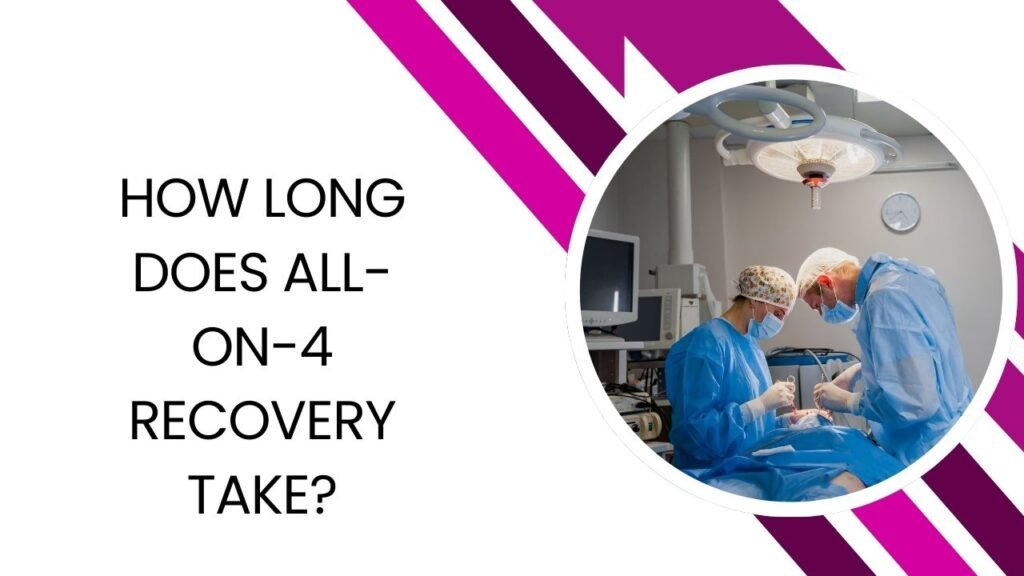How Long Does It Take To Recover From All-on-4 Surgery?
Considering All-on-4 dental implants? Understanding the recovery timeline can make your journey smoother and less stressful.
This comprehensive guide breaks down the recovery process, answering the critical question: “How long does it really take to recover from All-on-4 surgery?” With detailed stages and expert tips, you’ll know exactly what to expect and how to manage your recovery effectively.
What Is All-on-4 Surgery?
All-on-4 is a revolutionary dental implant procedure designed for patients with missing teeth. By placing four strategically positioned implants in the jaw, dentists can support a full set of prosthetic teeth. This method is less invasive compared to traditional implant procedures and offers a quicker, more comfortable recovery.
How Long Does All-on-4 Recovery Take?

In general, the recovery from All-on-4 surgery takes about 2 to 6 months. Here’s a breakdown of what to expect at each stage of your healing process:
Immediate Post-Surgery (1-3 Days)
- Swelling and Discomfort: Expect noticeable swelling and tenderness immediately after the surgery. This is a natural part of the healing process.
- Pain Management: Use prescribed pain medications or over-the-counter options like ibuprofen. Applying ice packs to your face can help reduce swelling.
- Diet: Stick to a diet of soft foods such as yogurt, mashed potatoes, and soups to avoid putting strain on your implants.
The First Week
- Swelling and Pain: Swelling should start to decrease, and discomfort will gradually lessen.
- Dietary Restrictions: Continue with a soft food diet. Gradually introduce more solid foods as your comfort allows.
- Oral Hygiene: Rinse with warm salt water and use a soft-bristled toothbrush. Avoid brushing directly on the implant sites.
Weeks 2-6
- Swelling and Pain: Significant improvements should be noticeable. Pain and swelling will continue to reduce.
- Diet: You can start reintroducing regular foods, but be cautious with hard or crunchy items.
- Oral Hygiene: Maintain excellent oral hygiene practices and continue with gentle rinsing. Regular dental check-ups will be crucial to monitor healing.
6 Months and Beyond
- Osseointegration: By six months, your implants should have fully integrated with the jawbone. This process, known as osseointegration, is crucial for the stability of your implants.
- Permanent Dentures: Permanent dentures will be attached at this stage, and you should experience full functionality and aesthetics.
Managing Discomfort After All-on-4 Surgery
Pain Relief Options
- Medications: Your dentist may prescribe specific pain relievers or recommend over-the-counter options.
- Ice Packs: Applying ice packs to your face can help reduce swelling and numb discomfort.
- Salt Water Rinses: Gentle rinsing with salt water can soothe your gums and aid in the healing process.
Common Discomforts
- Bruising and Bleeding: Minor bruising and bleeding are normal. If symptoms worsen, contact your dentist.
- Nerve Sensitivity: Some patients experience temporary nerve sensitivity, which should resolve as healing progresses.
Dietary Considerations for All-on-4 Recovery
Initial Diet
- Soft Foods: Focus on soft foods like yogurt, mashed potatoes, smoothies, and soups to prevent damaging your implants.
- Avoid Hard Foods: Refrain from hard or crunchy foods until you receive clearance from your dentist.
Gradual Transition
- Reintroducing Regular Foods: As your recovery progresses, gradually reintroduce regular foods. Chew slowly and carefully to avoid putting undue pressure on your implants.
Oral Hygiene After Surgery
Why It Matters
Maintaining excellent oral hygiene is crucial to prevent infection and ensure the success of your All-on-4 implants.
Recommended Practices
- Toothbrush: Use a soft-bristled toothbrush to avoid irritating the implant sites.
- Flossing: Employ gentle flossing techniques to clean around your implants.
- Mouthwash: Rinse with a dentist-approved mouthwash after meals to keep your mouth clean and promote healing.
Returning to Normal Activities
Rest and Recovery
- Initial Rest: Rest is crucial in the first few days post-surgery. Avoid strenuous activities and give your body time to heal.
- Returning to Work: Most people can return to work within a few days. Listen to your body and avoid activities that could strain your recovery.
Gradual Increase in Activity
- Physical Activity: As your recovery progresses, gradually increase physical activity. Consult with your dentist to ensure that your activity level is appropriate for your healing stage.
Potential Complications
What to Watch For
- Infection: Signs include severe swelling, persistent pain, or unusual discharge. Contact your dentist immediately if you notice these symptoms.
- Bleeding: Excessive bleeding or prolonged bleeding should be reported to your dentist.
- Nerve Damage: Symptoms like persistent numbness or tingling should be evaluated by your dentist.
Long-Term Care and Maintenance
Ongoing Care
- Regular Check-Ups: Schedule regular dental check-ups to monitor the health and stability of your implants.
- Oral Hygiene: Continue practicing excellent oral hygiene to ensure the long-term success of your All-on-4 implants.
FAQ Section
Here are answers to some frequently asked questions about All-on-4 recovery:
- How long does it take to recover from All-on-4 surgery?
Recovery typically takes 2 to 6 months, with initial swelling and discomfort easing within the first few days. - Can I return to work after All-on-4 surgery?
Most individuals can return to work within a few days, depending on their recovery progress. - What pain medications are typically prescribed?
Your dentist may prescribe specific medications or recommend over-the-counter options like ibuprofen. - What are the signs of infection after All-on-4?
Look for severe swelling, persistent pain, or unusual discharge. Contact your dentist if these occur. - Will I experience any limitations when speaking after surgery?
Some temporary speech limitations may occur, but these should improve as you heal.
Conclusion
Understanding the All-on-4 recovery process can help you navigate your healing journey with confidence. From the initial post-surgery discomfort to the long-term care needed for your implants, this guide provides a clear and detailed roadmap.
By following these steps and maintaining good oral hygiene, you’ll be well on your way to enjoying a functional and aesthetically pleasing smile.